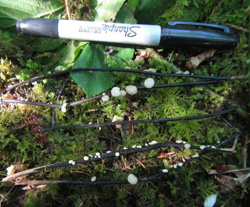Summary
 The research will investigate the ecological genetics of the ash dieback pathogen Hymenoscyphus fraxineus and its ability to evolve in response to natural selection.
The research will investigate the ecological genetics of the ash dieback pathogen Hymenoscyphus fraxineus and its ability to evolve in response to natural selection.
Research objectives
The objectives of this research are to:
- Examine variation in the genetic diversity and pathogenicity of H. fraxineus between populations and within trees using a number of different approaches.
- Explore the relationship between the recently arrived H. fraxineus and its cousin H. albidus, which is native to the UK and harmless to our native ash species Fraxinus excelsior.
- Determine if viruses might offer a control for ash dieback disease.
Results so far
The research on ash dieback contributes to the process of breeding and management of natural and commercial ash populations, helping to control this aggressive disease as well as provide insights into the operation of natural selection on this recently arrived pathogen.
Our study on genetic diversity of H. fraxineus shows that the UK population is highly heterogeneous with little evidence of founder effects. This suggests that numerous individuals of H. fraxineus have initiated infection at many sites, with infection occurring either through the planting of infected stock or through wind borne spores originating from continental Europe disease outbreaks. The genetic similarity between pathogen populations in the UK and continental Europe also highlights the connections between the outbreaks in continental Europe and the UK.
As part of our work we have developed a multiplex PCR assay to detect and discriminate between the invading and native species of Hymenoscyphus. Using this assay, we were able to regularly find native H. albidus at several sites across England and Wales, but as these were colonised by H. fraxineus we observed the loss of H. albidus. Replacement of our native non-damaging H. albidus by the highly pathogenic H. fraxineus appears to be occurring with some rapidity at the sites we analysed and very probably elsewhere in Britain.
Studies on the potential of viruses to control ash dieback have revealed that the ssRNA virus HfMV1 is present at moderate to high frequencies in subpopulations of H. fraxineus throughout the UK. This is in line with recent findings elsewhere in Europe. Because HFMV1 is already so widespread but apparently has little or no debilitating effect on the fitness of the pathogen, the likelihood of achieving biocontrol with this particular virus appears unlikely.
Funders and partners
This research is being undertaken with the John Innes Centre and is led by Prof James Brown. It is 80% funded under the auspices of the Living With Environmental Change Partnership with support from the Biotechnology and Biological Sciences Research Council, Department for Environment, Food and Rural Affairs, Economic and Social Research Council, Forestry Commission, Natural Environment Research Council and the Scottish Government and 20% funded through the Forestry Commission research programme Understanding Biotic Threats
Forestry Commission policy
This research underpins the evidence base for the delivery of healthy and resilient forests and wider ecosystems (see Tree Health management plan)
